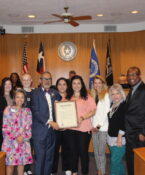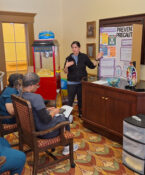Rural primary care: TCOM prepares students to wear many hats
What does it take to be a primary care doctor in a rural setting?
They face challenges that not everyone can handle. They may be the only physician in town and for surrounding miles, serving as pediatrician, geriatrician, obstetrician, at times even the ER doctor.
Meeting the need
The Texas College of Osteopathic Medicine has a special curriculum for prospective rural physicians. It’s called Rural Osteopathic Medical Education of Texas (ROME). These Rural Scholars visit a rural clinic and its physician before ever setting foot in a classroom. The relationship with practicing physicians and other providers continues throughout the student’s medical education.
The community-based curriculum introduces student doctors to the rural environment. They work with faculty preceptors from rural communities across the state. They can "try on" the life of a rural physician to see how it fits. US News & World Report ranked the program ranked 15th in the nation this year.
In addition:
- 84 percent of ROME graduates entered a primary care residency
- 60 percent of ROME graduates entered family practice residencies
Playing many roles
"The rural physician doesn’t have the luxury of referring patients to specialists," says John Bowling, DO, Professor and Assistant Dean of Rural Medical Education. "In towns like Comanche or Bastrop, the rural health professional has to be prepared for just about anything. One of our adjunct faculty in Eagle Lake even helped organize the influx of thousands of people racing away from a hurricane on the Texas coast. Our students are immersed in the rural lifestyle in their first year and learn to wear many hats."
The rural physician will likely be called upon for leadership in diverse settings – nursing home medical director, athletics team physician, hospice director. "One of our adjunct faculty is a 4-H judge in Eastland. Another is emergency services director in Liberty," Bowling says. "The community often dictates how the physician can best serve."
Benefits of rural practice
A common myth is that physicians avoid the rural setting because they won’t be able to repay large medical school loans or support a family. In fact, the rural family physician is more likely in his own clinic to provide colonoscopies, bone density scans, minor surgery and obstetrics, than can his urban counterparts. These procedures are highly reimbursable and should enable the doctor to meet his financial obligations. The rural physician in Texas earns a good living.
"You can raise a family in a less hectic environment, be intricately involved in the success of a town and be appreciated by the community you serve," Bowling says.



![Uyen Sa Nguyen Scaled[58]](https://www.unthsc.edu/newsroom/wp-content/uploads/sites/16/Uyen-Sa-Nguyen-scaled58-145x175.jpg)

Social media